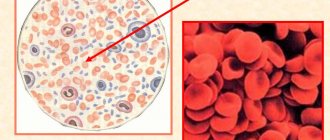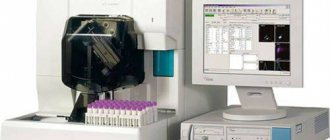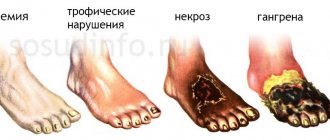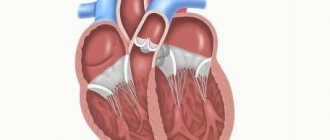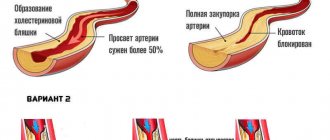© Author: A. Olesya Valerievna, candidate of medical sciences, practicing physician, teacher at a medical university, especially for SosudInfo.ru (about the authors)
Ischemia is a special pathological process that is characterized by insufficient supply of arterial blood to organs and tissues . It is not an independent disease, but accompanies a variety of pathologies as its root cause and the main pathophysiological mechanism of development.
Ischemia is the basis of cerebrovascular pathology, when the brain experiences a lack of nutrition, and coronary heart disease is a whole group of diseases that arise solely due to a lack of arterial blood supply to the heart.
ischemia using the example of the heart muscle (myocardium)
The cause of ischemic lesions is, first of all, a vascular factor, and it is not so important whether the vessel is clogged from the inside or compressed from the outside, and in some cases irreversible changes occur in the vascular walls themselves, leading to a lack of blood flow. The picture that is observed in organs during ischemia is largely stereotypical and is associated primarily with hypoxia.
The concepts of hypoxia and ischemia should not be confused. Hypoxia is a broader phenomenon that reflects a lack of oxygen due to external or internal causes, while the vessels may be passable and quite capable of delivering the required volume of blood. With ischemia, there is often a local problem that leads not only to hypoxia, but also to a variety of other metabolic disorders. In addition, hypoxia is considered reversible, while ischemia is potentially dangerous due to the development of a heart attack with the death of a tissue area.
Different organs respond to ischemia differently. This is due to the characteristics of the blood supply and functional activity of the tissue. For example, bones and cartilage are able to withstand a lack of arterial blood for quite a long time without changing or causing symptoms of pathology, while the brain, heart and kidneys are extremely vulnerable and are the very first to feel the ischemic effects.
The severity of ischemia and its consequences depend on the rate of progression of the disorder, the type of tissue, the degree of obstruction of the vessel, the general condition of the body, but in all cases suspicious of ischemic processes anywhere in the body, a thorough examination of the patient is necessary, and often a serious treatment.
Causes and risk factors
The development of ischemia can lead to:
- atherosclerotic changes in the coronary arteries, preventing collateral blood flow;
- blood diseases;
- acute blood loss;
- heart failure;
- severe stress;
- injuries of varying severity;
- embolism;
- thrombosis;
- shock (cardiogenic, pain, burn);
- tendency to spasms of arteries in the area of ischemia;
- mechanical compression of the vessel by the tumor;
- intestinal obstruction;
- increased blood viscosity;
- poisoning by biological and chemical poisons;
- thickening of the walls of blood vessels;
- obliterating endarteritis;
- torsion of a tumor, polyp or pedunculated fibroid;
- anemia;
- osteochondrosis.
Risk factors for developing ischemia:
- heart rhythm and conduction disorders;
- tendency to thrombosis;
- high blood cholesterol levels;
- genetic and hereditary factors (susceptibility to thrombosis, blood diseases, family history of vascular diseases, abnormal vascular tortuosity);
- blood viscosity, which increases the resistance to blood flow.
- unhealthy lifestyle (alcohol abuse, nicotine addiction, sedentary lifestyle, excess body weight);
- age factor (women over 55, men over 45–50);
- long-term use of hormonal drugs by women.
The risk of coronary heart disease increases in the presence of diabetes mellitus, hypertension, atherosclerosis, thromboangiitis obliterans, chronic severe anemia, chronic neuritis of the sciatic nerve, and coxarthrosis.
The consequences of ischemia include myocardial infarction, stroke, heart failure, cardiogenic shock, electrical instability of the heart, paresis and paralysis when motor areas of the brain are damaged.
Diet, nutrition for ischemia
Diet for cleansing blood vessels for diseases of the cardiovascular system
- Efficacy: therapeutic effect after 3 months
- Timing: constantly
- Cost of products: 1700-1800 rubles. in Week
Diet for coronary heart disease
- Efficacy: therapeutic effect after 30 days
- Timing: constantly
- Cost of products: 1700-1800 rubles. in Week
Diet for stroke
- Efficacy: therapeutic effect after 1 month
- Timing: constantly
- Cost of food: 1700-1900 rubles per week
Forms
According to the nature of the flow, they are distinguished:
- acute ischemia - occurs as a result of a sharp slowdown or cessation of blood flow in a certain area;
- chronic ischemia – develops with a gradual disruption of blood circulation.
According to the etiological factor, the following forms of ischemia are distinguished:
- angiospastic – caused by a long-term reflex spasm of a blood vessel, leads to tissue hypoxia, creates conditions for starting the process of active thrombus formation;
- redistribution (a type of angiospastic) – caused by the redistribution of blood flow between organs due to a decrease in the volume of circulating blood;
- obstructive – associated with thrombus formation, occurs when there is an obstruction to blood flow in the artery, complete or partial closure of the artery lumen by a thrombus, atherosclerotic plaque or embolus;
- compression - occurs when external mechanical compression of the wall of an artery or a section of tissue by a connective tissue scar, adhesions, an increasing tumor, trauma, tourniquet, or foreign body.
A separate group includes neonatal ischemia, which can be a consequence of intrauterine and extrauterine hypoxia, asphyxia, disturbances of the placental blood supply, severe anemia, maternal gestosis, infections, placenta previa or abruption, arterial hypotension or hypertension. Ischemia in newborns can cause the development of serious neurological disorders.
Source: fb.ru
Types of ischemia and the changes it provokes
Ischemia can be acute or chronic. Its duration determines the nature of the structural restructuring of the tissue, and the depth of the changes will depend on the sensitivity of the tissue to the lack of oxygen and the degree of insufficient blood supply to the organ.
chronic and acute ischemia using the example of the brain
The duration and speed of development of the pathological process are important prognostic factors for anemia. The faster the overlap occurs, the deeper the damage will be in the tissue, since collateral (bypass) blood flow pathways do not have time to turn on in a short time. A long-term ischemic process leads to irreversible sclerotic and dystrophic changes, in contrast to short-term ischemia, which can stop at the subcellular level.
The changes that develop in tissue under ischemic conditions are caused by insufficient oxygen supply. This can be intracellular damage during short-term and superficial ischemia or deep destructive processes resulting in organ infarction.
Acute ischemia causes dystrophy and necrosis, which are preceded by changes at the ultrastructural level - destruction of cell components, slowing down the activity of enzymes and biochemical reactions. This type of anemia is considered a pre-infarction condition, followed by the heart attack itself.
If ischemia is prolonged, atrophy begins in the tissue, and constant hypoxia activates connective tissue cells, fibroblasts, which begin to actively form collagen. The consequence of prolonged ischemia is sclerosis.
Among the causes of ischemia of various organs are:
- Thrombosis and embolism;
- Atherosclerosis;
- Arrhythmias;
- Arterial hypotension and shock;
- Compression from the outside by a tumor, foreign body, ligature;
- Congenital anomalies of arterial development;
- Focal vasospasm.
There are several types of ischemia:
- Angiospastic;
- Obstructive;
- Compression;
- Redistributive.
Angiospastic ischemia is associated with spasm of arterial vessels, which can be caused by pain, the effects of medications, cold, emotional experiences or injuries, infections, fever and many other reasons. This ischemia is transient and, as a rule, short-term, but under pathological conditions the spasm can be quite long-lasting and even cause a complete stop of blood flow.
Angiospastic vascular ischemia most often appears when large arteries narrow - coronary arteries in the heart, one vessel from paired organs with irritation of the opposite artery (kidney, for example). A serious threat is posed by brain tumors, strokes, and toxic damage to nervous tissue, which can lead to increased activity of the vasomotor center and subcortical structures with the development of widespread vasospasm and ischemia in the tissues.
the main causes of ischemia (using the example of the heart) are vascular spasm, blockage of the vessel with cholesterol plaque and thrombus
The obstructive type of ischemia is a consequence of blocking the lumen of the vessel from the inside. The cause of obstruction may be a thrombus, an embolus, sclerosis of the arterial wall or its inflammation, or an atherosclerotic plaque. Obstruction by thrombotic masses is often accompanied by vascular spasm, and spasm can provoke subsequent thrombosis or embolism.
Compression anemia develops due to compression of an arterial vessel by a neoplasm, ligature, exudate, or a tourniquet. Compression of the artery can also be caused by a foreign body acquired during trauma or a gunshot wound.
The redistributive type of anemia occurs after anemia. For example, fluid has accumulated in the abdominal cavity. After the contents are removed, the vessels of the abdominal cavity expand sharply and are filled with arterial blood, while other organs will experience a lack of it due to uneven distribution. This type of ischemia is associated with cases of fainting after removal of ascitic fluid, which are caused by a temporary lack of arterial blood supply to the brain.
A relatively harmless type of ischemia is considered to be angiospastic, which can be eliminated with treatment or will go away on its own, and one of the most dangerous is obstructive, when the entire vessel is completely blocked in a short time, and necrosis develops in the tissue.
The outcome of ischemia and its significance for the body are determined by the organ in which the disorder occurred . More severe consequences are typical for anemia of vital organs - heart, brain, kidneys. Ischemia of the spleen, respiratory organs, and liver is more easily tolerated, which, in turn, is more severe than anemia of bones, cartilage or muscles. The more active the biochemical processes in tissues are, the more sensitive it is to the lack of arterial blood flow.
The degree of ischemic-dystrophic changes is also influenced by the development of the organ’s own vascular network. For example, the brain or heart are not sufficiently supplied with collateral blood flow pathways, so ischemia in them quickly turns into necrosis. The lungs and liver essentially have two sources of blood supply and abundant vascular collaterals, so ischemia in them is less pronounced.
Another factor on which the course of ischemia depends is the initial functional state of the tissue: the higher the level of metabolism, the greater the need for oxygen, and with its deficiency, degeneration is stronger and necrosis is more likely.
Stages
Depending on the intensity of symptoms, three stages of ischemic disease are distinguished:
- Compensated (spastic) – characterized by vascular regulation disorders; tissue hypoxia is compensated by collaterals, which take on part of the load, cover the tissue’s need for oxygen and maintain a blood flow reserve. Amenable to drug therapy;
- Subcompensated – characterized by the appearance of structural signs of atherosclerotic vascular lesions, ischemic lesions, trophic disorders, irreversible changes. The blood flow rate is critical, pain occurs at rest, vascular drug therapy is ineffective;
- Absolute – leads to the appearance of severe trophic disorders, irreversible changes and complete dysfunction of the affected organ (ischemic ulcers, necrosis of organs and body parts, sclerosis, heart attack).
In case of severe vascular obstruction and severe ischemia, they resort to normalization of blood circulation using balloon angioplasty and stenting.
Cerebral ischemia in newborns
In newborns, cerebral ischemia manifests itself as a result of cerebral hypoxia, that is, insufficient oxygen supply to the baby’s brain during gestation or during childbirth.
Based on the symptoms and results of ultrasound examination of the brain, it is customary to distinguish three degrees of cerebral ischemia. With a mild degree of cerebral ischemia, excessive excitation or depression may occur in the first week of life. With moderate severity of the disease, such disorders last longer, and convulsions may occur periodically. Children with severe cerebral ischemia must be urgently admitted to the intensive care unit. With a mild degree of ischemia, the prognosis is favorable: as a rule, the child recovers completely after a few weeks. For more severe forms of the disease, treatment measures should be determined by a doctor.
Signs of ischemia
Manifestations of ischemia depend on the degree of decrease in the intensity of blood supply to the tissue and other microcirculation disorders. The main symptoms of coronary artery disease depend on which organ is affected.
Symptoms of chronic cerebral ischemia:
- frequent dizziness;
- memory disorders, impaired ability to concentrate;
- impaired coordination of movements;
- blurred vision;
- feeling of lack of air;
- hearing impairment;
- noise, ringing in the ears.
Acute cerebral ischemia (ischemic stroke) is a serious life-threatening condition. The first signs of ischemia:
- sharp, intense headache, dizziness;
- fainting, other disturbances of consciousness;
- visual impairment;
- stupor, stupor, severe lethargy;
- numbness, weakness of the upper and lower extremities;
- pain in the heart, arrhythmias;
- increased sweating;
- tachycardia;
- impaired coordination of movements;
- paralysis.
Symptoms of intestinal ischemia:
- nausea, vomiting;
- increased peristalsis, frequent urge to defecate;
- diarrhea;
- streaks of blood in the stool;
- severe abdominal pain.
Symptoms of ischemia of the lower extremities are usually pronounced:
- pain in the calf muscles, which intensifies at night and when walking;
- gait disturbances, intermittent claudication;
- coldness of the extremities, marbled skin tone;
- the formation of trophic ulcers on the feet and toes.
Coronary heart disease has the following manifestations:
- angina pectoris;
- tachycardia;
- chest pain (usually with severe psycho-emotional shock or physical exertion);
- dyspnea;
- pale, bluish skin;
- weakness;
- pain in the left hand;
- decrease in blood pressure.
Myocardial ischemia can occur without severe pain; in this case, it is detected during examination of the heart.
All tissues and organs in the human body have varying sensitivity to lack of blood supply. Cartilage and bone structures are less susceptible, the brain and heart are more vulnerable.
Diagnosis of cerebral ischemia
First of all, the doctor examines the patient’s medical history, paying attention to the presence of characteristic components: myocardial infarction, cardiac ischemia, angina pectoris, arterial hypertension, etc. A physical examination is mandatory, which reveals pathologies in the functioning of the cardiovascular system. In the process of laboratory research, the causes of the development of the disease are determined. It is also recommended to conduct a number of instrumental studies. Thus, the patient must undergo an ECG, echocardiography, ophthalmoscopy and a number of other specific studies prescribed by the doctor. Angiography of cerebral vessels is performed only in rare cases.
It is important to distinguish between cerebral ischemia and a number of somatic diseases, cancer, and mental disorders. It is sometimes especially difficult to differentiate ischemia from neurodegenerative diseases, which are characterized by cognitive disorders.
Treatment of ischemia
Treatment of ischemia is carried out with medications, physiotherapy, and surgical methods. Therapy is selected individually, depending on the form of the disease, its severity, concomitant diseases, general condition and age of the patient. Pharmacological treatment is aimed at correcting disorders and hemodynamic disturbances, eliminating the cause that provoked the development of coronary artery disease. Directions of therapy:
- relieving vasospasm;
- restoration of blood circulation in the tissue;
- normalization of vessel patency, expansion of arteries damaged by atherosclerosis, strengthening their walls;
- uncovering all possible bypass routes to the blood supply;
- stopping the development of cholesterol plaques;
- eliminating the cause of vessel blockage, removing a blood clot;
- decreased blood viscosity;
- increased oxygen content in the blood;
- creating conditions for the formation of a collateral network;
- protection of ischemic tissue of the damaged organ;
- treatment of concomitant heart diseases and cerebrovascular insufficiency.
For this purpose, thrombolytics, prostaglandins, and drugs that improve blood circulation are prescribed. In the acute form of the pathology, they are used in the form of intravenous infusions, after the acute symptoms subside, and in chronic ischemia - in tablet form.
The risk of coronary heart disease increases in the presence of diabetes mellitus, hypertension, atherosclerosis, thromboangiitis obliterans, chronic severe anemia, chronic neuritis of the sciatic nerve, and coxarthrosis.
Non-drug methods in the treatment of ischemia play as important a role as drug therapy. This is, first of all, lifestyle correction, dieting, normalization of body weight, water regime, which allows normalizing increased blood clotting.
Source: syl.ru
In case of severe vascular obstruction (carotid artery stenosis more than 60%) and severe ischemia, they resort to normalization of blood circulation using balloon angioplasty and stenting. An effective means of relieving critical ischemia is microsurgical arterial bypass. To restore the lumen of the carotid arteries, endarterectomy is performed.
Symptoms
Symmetrical spasm of the adductor arteries in various parts of the body, pallor of the face from strong affect (for example, fear), fainting during rapid blood extraction, deterioration in organ function and the degree of its sensitivity due to impaired nutrition of nerve endings are the main symptoms of reflex ischemia.
Ischemia as a result of arterial spasm usually does not last long and ends without significant consequences. In some situations, vasospasm may last longer when the heart muscle or brain needs oxygen, leading to a heart attack.
Prevention
Preventive measures to prevent the development of ischemia or reduce existing ones:
- nutrition correction;
- increased physical activity;
- normalization of body weight;
- drinking enough liquid;
- rejection of bad habits;
- normalization of blood pressure and lipoprotein levels;
- maintaining the nervous system in a stable state;
- control of blood viscosity in individuals at risk.
Video from YouTube on the topic of the article:
Causes
Let's consider the most common irritants of vasospasms:
- various injuries: domestic, surgical, gunshot, burns, especially if they are accompanied by pain and fear;
- medications: herbal, animal, mineral, bacterial toxins and the manifestation of an allergic reaction to them;
- the effect of low ambient air temperature on the human body;
- systematic use of hormonal drugs catecholamines (dopamine, adrenaline, norepinephrine) or vasopressin (antidiuretic hormone that controls the amount of water in the body);
- in a state of strong excitement or irascibility;
- with pathological changes in the diencephalon;
- with some toxic substances, for example, ergotine. It is found in ergot, a parasitic, poisonous fungus that appears in the ears of rye and other cereals.
The above factors act on the vasomotor centers (vasomotor) and the nervous structure of blood vessels.

